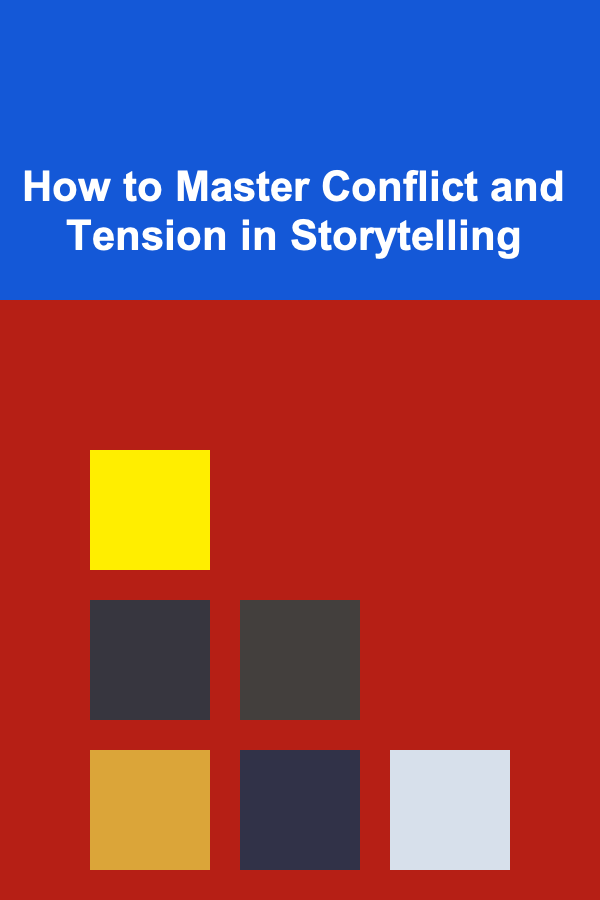
How to Master Conflict and Tension in Storytelling
ebook include PDF & Audio bundle (Micro Guide)
$12.99$6.99
Limited Time Offer! Order within the next:

Conflict and tension are the lifeblood of compelling storytelling. These elements form the backbone of any narrative, driving characters, plot, and emotions. Without conflict, stories fall flat, and without tension, audiences lose interest. Mastering the balance of these elements is crucial for creating stories that captivate and engage. Whether you are writing a novel, screenplay, or short story, understanding how to use conflict and tension effectively is key to crafting a narrative that resonates with your audience.
The Nature of Conflict and Tension in Storytelling
At its core, conflict is the struggle between opposing forces, whether internal, external, or both. Tension, on the other hand, refers to the emotional or psychological strain that the audience feels as they witness the unfolding conflict. These two elements work hand in hand to create a story that keeps readers or viewers invested in what happens next.
1. Conflict in Storytelling
Conflict serves as the engine of the narrative. It's the problem or challenge that the protagonist must overcome. Without conflict, there's no narrative arc, and the story lacks purpose. There are different types of conflict, each serving a distinct role in the story:
- Internal Conflict: This is the struggle that occurs within the protagonist. It's often psychological, emotional, or moral in nature. Internal conflict deals with the character's desires, fears, guilt, or dilemmas. For example, Hamlet's indecision about avenging his father's death creates an internal conflict that drives the tragedy forward.
- External Conflict: This is the struggle between the protagonist and an outside force, whether it be another character, society, nature, or fate. External conflict is often more visible and easier to identify. Classic examples include a hero battling a villain or a person fighting against oppressive systems.
- Interpersonal Conflict: This form of conflict occurs between two or more characters. It can arise from differences in values, desires, or perspectives. The tension between characters can fuel the plot, especially when the conflict escalates, revealing deeper emotional stakes. A prime example is the rivalry between Sherlock Holmes and Professor Moriarty.
- Social Conflict : This type of conflict pits an individual or group against societal norms, expectations, or systems. It highlights the struggles of characters who challenge the status quo or face injustice, as seen in stories like The Handmaid's Tale or Les Misérables.
- Environmental Conflict: Sometimes the conflict comes from nature itself, whether it's a survival story set in the wilderness or a catastrophe like an earthquake or a storm. These narratives often test the physical and emotional limits of characters.
Understanding the different types of conflict helps you develop multidimensional stories, where the protagonist's struggles can resonate on multiple levels.
2. Tension in Storytelling
While conflict drives the plot, tension is the force that makes the audience care about the conflict. Tension is the emotional or psychological pressure that builds as the conflict progresses. It creates a sense of anticipation, uncertainty, or dread, which compels the audience to keep reading or watching. There are several ways tension can be crafted in storytelling:
- Rising Action: This is the build-up of tension throughout the narrative. As the conflict intensifies, the stakes become higher, and the protagonist's actions become more consequential. This escalation of tension creates an emotional roller coaster that keeps the audience on edge.
- Pacing: The way you pace the narrative can have a significant impact on the tension. Slow, deliberate pacing can build a sense of unease, while fast-paced action scenes can create a feeling of urgency. By alternating between moments of tension and release, you can control the emotional highs and lows of your story.
- Foreshadowing: Foreshadowing creates tension by hinting at what's to come. By planting subtle clues or ominous signs, you build anticipation and suspense. This allows the audience to feel like they are in on the secret, heightening the tension as they await the reveal.
- Uncertainty: Creating uncertainty in a story is a powerful way to build tension. This can be done by keeping key information from the audience or the characters, forcing them to make decisions or take actions based on incomplete knowledge. A mystery or thriller often uses uncertainty to drive tension, keeping the audience guessing.
- Conflict with Consequences: Tension is most effective when the conflict has real consequences. Whether the stakes are life and death, personal relationships, or moral dilemmas, the tension is heightened when the audience believes that the outcome matters. The characters must face difficult decisions that will shape the direction of the story.
- Conflict within Relationships: Relationships are often at the heart of tension in storytelling. The emotional investment of the audience in the characters' relationships makes the stakes feel personal. Whether it's a romantic relationship, a friendship, or a familial bond, the emotional conflict within these connections can create powerful tension.
3. The Role of Characters in Conflict and Tension
Characters are the driving force behind both conflict and tension. Their desires, fears, motivations, and actions determine how conflict unfolds and how tension is built. Here's how different types of characters contribute to conflict and tension:
- Protagonists: The protagonist's journey is typically centered around their conflict. They are the characters who are most affected by the events of the story. To create tension, the protagonist's motivations should be clear, and their conflict should challenge them in significant ways. The audience should care about the protagonist's success or failure, which is what makes the tension meaningful.
- Antagonists: The antagonist is the force or character that opposes the protagonist. The antagonist's actions or beliefs often create the conflict that drives the narrative. For tension to be effective, the antagonist should be formidable, whether they are a physical threat, a psychological challenge, or a force of nature. A well-developed antagonist creates a sense of danger and urgency.
- Supporting Characters: Supporting characters, whether allies or foils, play a crucial role in escalating or alleviating tension. They may offer help or introduce new obstacles, and their relationships with the protagonist can add complexity to the conflict. These characters often highlight different facets of the central conflict and can serve as emotional touchstones for the audience.
- Conflicted Characters: Characters who experience internal conflict or moral dilemmas add depth to the narrative and tension to the story. The tension in these characters often stems from their inability to make a decision or their fear of the consequences of their actions. This creates a compelling emotional arc that resonates with the audience.
4. Techniques for Building Conflict and Tension
Mastering the art of conflict and tension requires a deep understanding of narrative structure and character development. Here are some techniques to help you build these elements effectively:
4.1 Establish Clear Stakes
To create meaningful conflict, the stakes must be clear from the beginning. What does the protagonist stand to gain or lose? The higher the stakes, the more tension you can build. Whether it's the survival of a character or the success of a mission, the audience should feel invested in the outcome.
4.2 Use Obstacles to Increase Tension
Every time a character encounters an obstacle, it raises the tension. Obstacles are not just physical; they can be emotional, social, or intellectual. The more difficult the obstacle, the more intense the tension. Whether it's a battle with a powerful antagonist or a personal struggle, obstacles are the catalyst for escalating conflict.
4.3 Create Momentary Relief
Tension is most effective when it is balanced with moments of relief. These moments allow the audience to breathe before the next wave of tension hits. Whether it's a quiet scene of reflection or a humorous moment, these pauses serve to intensify the next round of conflict by making it feel more dramatic.
4.4 Employ Miscommunication and Deception
Miscommunication, deception, and misunderstandings can be powerful tools for creating conflict and tension. These elements can introduce doubt, create confusion, and lead to decisions that escalate the conflict. Characters who misinterpret each other's actions or intentions can heighten the drama and deepen the emotional stakes.
4.5 Play with Timing and Pacing
The way you time the conflict and pace the story can significantly impact the tension. Consider how events unfold over time. Does the conflict escalate quickly, or does it simmer over time? The timing of key moments---whether it's the revelation of crucial information or the climax of a battle---can create peaks and valleys in tension that keep the audience engaged.
5. Conclusion
Conflict and tension are the essential ingredients for a compelling story. They drive the plot, deepen character development, and keep the audience on the edge of their seat. By understanding the different types of conflict, the ways tension is built, and how to manipulate these elements, you can craft stories that resonate emotionally and intellectually with your audience. Whether you are writing a novel, screenplay, or short story, mastering conflict and tension is crucial to creating a narrative that captivates and endures.

Beginner Guide: How to Start a YouTube Channel
Read More
How to Choose the Best Time Travel Romances
Read More
How to Make a Holiday Memory Jar for the New Year
Read More
How to Prevent Car Theft by Securing Your Driveway
Read More
How to Sell Your Antique Furniture at an Antique Fair: An Actionable Guide
Read More
How To Support Children's Positive Self-Concept
Read MoreOther Products

Beginner Guide: How to Start a YouTube Channel
Read More
How to Choose the Best Time Travel Romances
Read More
How to Make a Holiday Memory Jar for the New Year
Read More
How to Prevent Car Theft by Securing Your Driveway
Read More
How to Sell Your Antique Furniture at an Antique Fair: An Actionable Guide
Read More